You’re experiencing a revolutionary shift in artisan jewelry as 3D printing transforms traditional craftsmanship into digital innovation. This technology enables you to create complex geometries impossible through hand-carving, while specialized software like RhinoGold helps you design intricate pieces. You can integrate 3D printing with lost-wax casting for precious metals, reduce material waste, and offer unprecedented customization to your customers. The industry’s projected growth to $18.5 billion by 2030 reveals expanding creative possibilities that’ll reshape your artistic approach.
From Traditional Craftsmanship to Digital Innovation
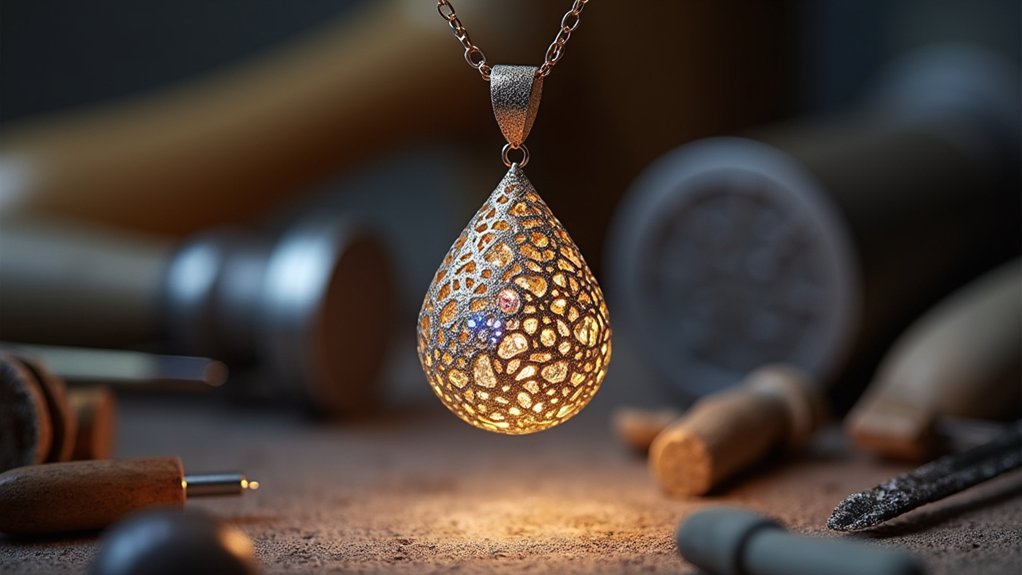
While traditional jewelry artisans once relied solely on hand-carving techniques and metalworking skills passed down through generations, today’s designers are embracing 3D printing technology to reveal creative possibilities that manual methods simply can’t achieve.
You’re witnessing a revolutionary fusion where ancient artistry meets cutting-edge innovation. Advanced techniques like Stereolithography capture intricate details and produce complex geometries that would be impossible through conventional approaches.
This digital transformation doesn’t replace traditional craftsmanship—it enhances it. You can now preserve historical aesthetics while pushing modern design boundaries, creating unique pieces that blend time-honored techniques with technological precision.
This evolution allows you to maintain the soul of artisanal work while accessing unprecedented creative freedom.
Essential Technologies for 3D Jewelry Production
As you explore 3D jewelry production, you’ll discover that several distinct printing technologies form the backbone of modern digital craftsmanship.
Each technology serves specific design requirements and material preferences in your creative process.
The four primary 3D printing technologies you’ll encounter include:
- Filament-based printing – Uses thermoplastic materials for prototypes and basic designs
- Powder-based printing – Creates detailed pieces through selective laser sintering
- Liquid resin printing – Delivers exceptional detail for intricate jewelry components
- Wax printing – Essential for lost-wax casting processes with precious metals
Creating your 3D file using specialized modeling software like Tinkercad or RhinoGold defines your piece’s specifications.
For precious metals like gold and silver, you’ll typically use wax 3D printing combined with traditional lost-wax casting methods, blending cutting-edge technology with time-honored techniques.
CAD Software and Digital Design Tools for Artisans
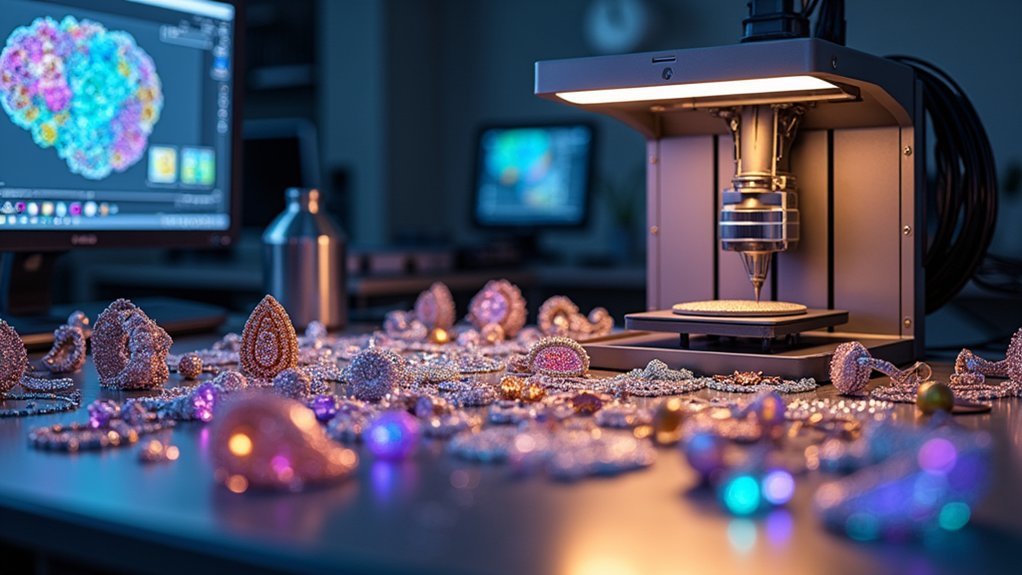
Once you’ve selected your printing technology, the real creative work begins with choosing the right CAD software to bring your jewelry concepts to life. Modern digital design tools like Tinkercad and RhinoGold enable you to create detailed 3D models while facilitating easy modifications and experimentation with complex forms.
| Software Type | Best For | Key Features |
|---|---|---|
| Beginner-Friendly | Learning basics | User-friendly interfaces |
| Professional | Complex designs | Advanced modeling tools |
| Cloud-Based | Collaboration | Instant price quotes |
You’ll find these programs offer accessibility for beginners while providing advanced features for experienced designers. The ability to generate accurate 3D files proves essential for successful printing, allowing you to present designs and receive feedback before production begins.
Lost-Wax Casting Enhanced by 3D Printing
When you combine 3D printing with lost-wax casting, you’re bridging centuries-old craftsmanship with cutting-edge technology to revolutionize jewelry production.
Your workflow transforms dramatically with this integration:
Your entire jewelry production process undergoes a revolutionary transformation when these two powerful technologies seamlessly merge together.
- Design Creation – You’ll start with CAD software to create detailed 3D models, then print them as wax-like resin prototypes.
- Sprue Attachment – You’ll attach wax sprues to form a casting ‘tree’ for efficient metal pouring.
- Intricate Detailing – You can achieve complex filigrees and pavé settings that traditional hand-carving can’t replicate.
- Rapid Prototyping – You’ll streamline modifications based on customer feedback before final casting.
This marriage of 3D printing and lost-wax casting enhances precision while reducing production time and costs.
You’ll deliver higher-quality pieces with intricate details that satisfy modern demands while honoring traditional craftsmanship techniques.
Material Options and Finishing Techniques
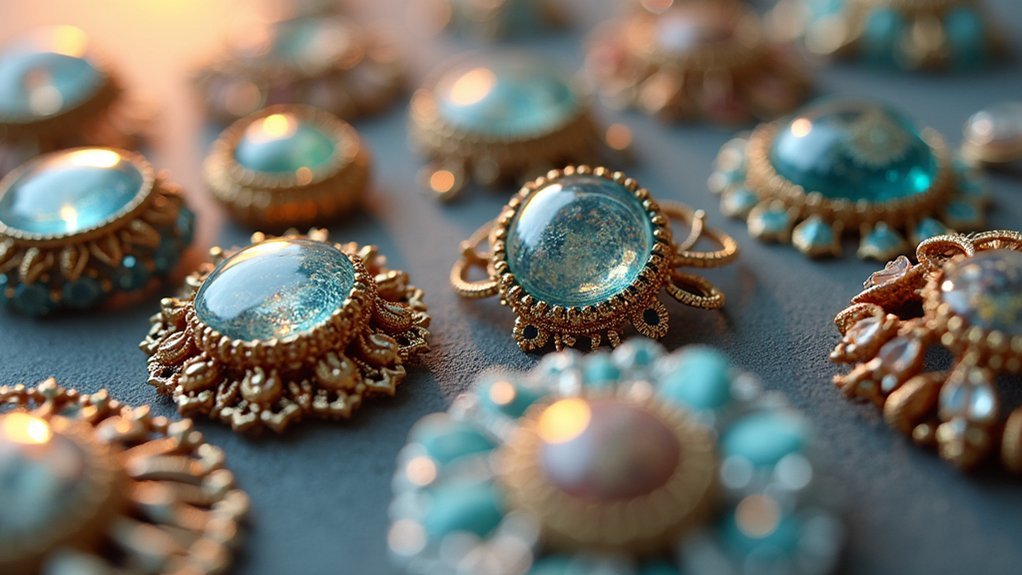
You’ll find that 3D printing opens up an impressive range of metal options for your jewelry designs, from affordable brass and bronze to premium silver and gold.
Each material brings its own aesthetic qualities and structural properties that’ll influence your design decisions and final piece durability.
The finishing techniques you choose—whether polishing, coating, or specialized surface treatments—can transform your printed piece from a rough prototype into a refined work that rivals traditional handcrafted jewelry.
Metal Material Varieties
Five primary metal materials dominate the 3D printing jewelry landscape: brass, silver, gold, bronze, and copper.
Each offers distinct aesthetic qualities and durability characteristics that’ll influence your final customized jewelry piece.
When selecting metal materials for your 3D-printed designs, consider these key factors:
- Brass – Affordable option with excellent detail retention and warm golden appearance
- Silver – Premium choice offering brilliant luster and corrosion resistance for heirloom pieces
- Gold – Ultimate luxury material providing exceptional durability and timeless appeal
- Bronze and Copper – Cost-effective alternatives delivering rich, earthy tones with unique patina potential
Understanding each material’s properties guarantees you’ll choose the right option for your specific design requirements, balancing aesthetic goals with budget considerations while maximizing the structural integrity of your finished piece.
Surface Finishing Methods
Once you’ve selected your metal material, surface finishing methods will determine your jewelry’s final appearance and tactile quality.
You’ll find several options to enhance your pieces’ aesthetic appeal, including polishing, plating, and texturing techniques.
Each metal requires specific finishing techniques to optimize its unique properties. Brass, silver, gold, bronze, and copper all respond differently to various surface finish applications.
Basic polishing offers an affordable starting point, while intricate finishes like gold plating increase your overall costs considerably.
For added durability, consider PU-coating, which provides a glossy finish and protection. A PU-coated bronze ring typically costs around 33 EUR.
Remember to review design guidelines specific to your chosen material before selecting finishing techniques, ensuring compatibility and achieving high-quality results.
Cost Analysis and Pricing Considerations
When you’re planning your 3D printing jewelry venture, you’ll face two primary cost considerations that directly impact your profitability.
Material prices can vary dramatically—you might pay around 33 EUR for a PU-coated bronze ring while a gloss silver piece costs approximately 57 EUR.
Your initial equipment investment will also require careful analysis, as printer costs range from affordable desktop models to high-end professional systems.
Material Price Variations
Material costs represent one of the most variable expenses you’ll encounter in 3D-printed jewelry production, with prices fluctuating dramatically based on your material selection. A PU-coated bronze ring might cost 33 EUR, while a gloss silver version jumps to 57 EUR, demonstrating how material choice directly impacts your budget.
Several factors influence these pricing variations:
- Metal type selection – Premium materials like silver command higher prices than bronze alternatives.
- Piece size and volume – Larger designs consume more material, increasing costs proportionally.
- Surface finish requirements – Specialized coatings and finishes add to material expenses.
- Design complexity – Intricate patterns may require specific materials suited for detailed work.
You can easily assess material costs through online 3D printing services, where uploading your design files generates instant quotes.
As printing technology advances, expect these material costs to become more competitive.
Equipment Investment Costs
Equipment investment represents a critical decision point that can make or break your jewelry business’s financial foundation.
You’ll find affordable plastic prototyping 3D printing options ranging from $300 to $1,000, making them accessible for creating initial designs and testing concepts. However, high-end metal printers demand five to six-figure investments, creating significant barriers for independent jewelry designers.
You can sidestep these upfront costs by utilizing online 3D printing services. Simply upload your designs and receive instant price quotes before production commitments. This approach eliminates equipment ownership burdens while maintaining design control.
Remember that printer ownership involves ongoing maintenance and safety requirements, especially with metal powder handling systems, adding operational expenses beyond initial purchase prices.
Customization and Personalization Benefits
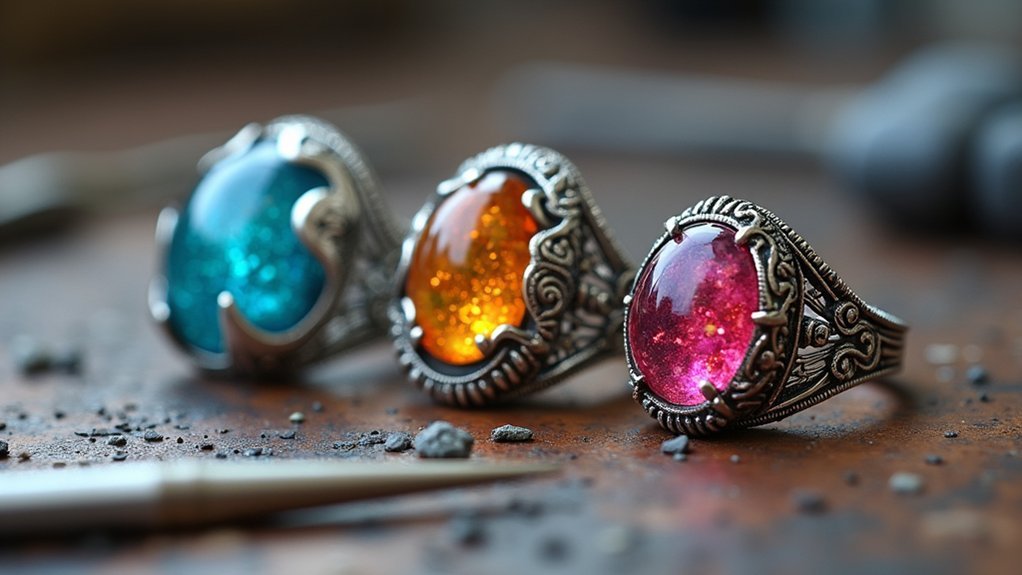
Since traditional jewelry customization required expensive tooling and lengthy production times, 3D printing technology has revolutionized how you can offer personalized pieces to your customers.
3D printing has transformed jewelry customization from an expensive, time-consuming process into an accessible, efficient solution for personalized pieces.
You’ll discover that customization options have become notably more accessible and cost-effective through digital workflows.
Here’s how 3D printing transforms your personalization capabilities:
- Immediate prototyping – Create try-on pieces for instant customer feedback and design validation
- Intricate detail work – Achieve complex personalized designs previously impossible with traditional methods
- Seamless modifications – Easily adjust 3D files to meet individual customer specifications
- Cost reduction – Eliminate expensive tooling requirements while maintaining high-quality results
You’ll find that this technology enables personalized designs as standard offerings rather than premium services, making custom jewelry accessible to broader customer segments.
Design Freedom and Creative Possibilities
You’ll discover that 3D printing reveals intricate pattern capabilities that were nearly impossible with traditional hand-carving methods, enabling you to create complex filigrees and detailed pavé settings with precision.
This technology breaks the constraints that once limited your creative vision, allowing you to explore innovative forms and styles through advanced stereolithography techniques.
You can now push beyond conventional boundaries and blend nostalgic ornamentation with contemporary elements, creating truly unique pieces that showcase both historical craftsmanship and modern design aesthetics.
Intricate Pattern Capabilities
When traditional hand carving reaches its limits, 3D printing opens up extraordinary possibilities for creating intricate jewelry patterns that were once impossible to achieve.
You can now craft delicate filigrees and complex pavé settings with unprecedented precision using advanced technologies like Stereolithography (SLA).
The intricate designs you’ll create through 3D printing include:
- Delicate filigree work with hair-thin metal threads forming elaborate patterns
- Complex pavé settings featuring numerous small stones in precise arrangements
- Interwoven geometric patterns that would break during traditional carving
- Multi-layered ornamental details with varying depths and textures
Breakthroughs in castable resins enhance your pattern detail capabilities, allowing you to blend nostalgic ornamentation with innovative forms that push creative boundaries beyond conventional jewelry-making limitations.
Breaking Traditional Constraints
These remarkable pattern capabilities represent just the beginning of how 3D printing transforms jewelry design by dismantling age-old manufacturing constraints.
You’re no longer bound by traditional metalworking limitations that once restricted your creative vision. With advanced castable resins and Stereolithography technology, you can design together complex geometries and delicate structures that were previously impossible to achieve through conventional methods.
You’ll find yourself experimenting freely, knowing that rapid prototyping encourages bold innovation without significant material waste.
The flexible digital workflow lets you modify designs instantly, incorporating client feedback in real-time. This liberation from traditional constraints enables you to merge historical ornamentation with cutting-edge aesthetics, creating personalized pieces that reflect both timeless craftsmanship and contemporary possibilities.
Streamlined Workflows and Production Efficiency
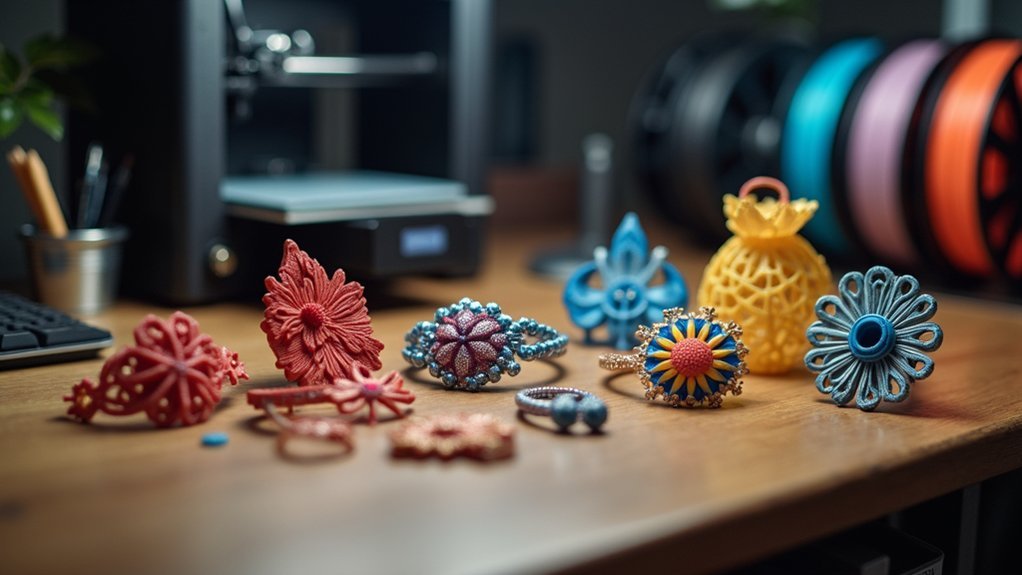
Since 3D printing eliminates traditional bottlenecks in jewelry production, you’ll discover that your design workflow becomes remarkably efficient. This technology transforms how you approach artisan jewelry creation, considerably reducing timeframes and costs.
Key efficiency improvements include:
- Rapid prototyping – You’ll create detailed prototypes quickly, cutting concept-to-production time considerably.
- Easy design modifications – CAD software integration lets you iterate rapidly based on customer feedback.
- Automated production processes – Robotic polishing systems process multiple units overnight, minimizing labor costs.
- Localized manufacturing – You’ll reduce overseas production dependency, enabling faster market response times.
Your production efficiency increases through precise printing techniques that eliminate material waste and remove traditional mold requirements.
This streamlined approach allows you to offer customized jewelry at lower costs while maintaining exceptional quality standards.
Quality Control and Detail Precision
The detail precision you’ll experience with castable resins enables patterns and features that traditional techniques can’t replicate.
You can rapidly adjust prototypes based on feedback, ensuring each piece meets your exact specifications.
When you combine digital workflows with conventional casting methods, you’ll create a controlled production environment that minimizes defects like metal porosity while maintaining exceptional quality standards throughout your entire jewelry creation process.
Sustainable Materials and Environmental Impact
While traditional jewelry manufacturing often generates substantial waste through subtractive processes, 3D printing enables you to create pieces using only the material you actually need. This revolutionary approach markedly reduces environmental impact while maintaining exceptional quality.
3D printing technology transforms sustainability through:
- Biodegradable resins and recycled metals that minimize ecological footprint
- Lightweight designs that reduce material consumption amid rising precious metal costs
- Supply chain transparency ensuring ethical sourcing and labor practices
- Advanced material science developments creating durable, eco-friendly options
You’ll benefit from using sustainable materials specifically engineered for 3D printing applications.
The market’s projected growth to $18,500 million by 2030 reflects growing consumer demand for environmentally responsible jewelry options that don’t compromise on craftsmanship or aesthetic appeal.
Market Adoption and Industry Trends
As consumer preferences shift toward personalized and sustainable luxury goods, you’re witnessing unprecedented adoption of 3D printing technology across the jewelry industry.
The market’s projected growth to $18.5 billion by 2030 with a 14.50% CAGR demonstrates this transformation’s magnitude. Independent jewelers are embracing affordable desktop printers and digital workflows, democratizing access to advanced design capabilities previously reserved for large manufacturers.
You’ll notice significant changes in jewelry production timelines and costs, making customization accessible to broader markets. Advanced castable resins enable intricate designs that traditional craftsmanship couldn’t achieve.
The technology’s sustainability benefits align perfectly with industry trends toward eco-friendly practices, positioning 3D printing as both an innovative solution and environmental imperative for modern artisan jewelers.
Future Developments in Artisan 3D Printing Technology
Beyond today’s innovations, revolutionary technologies are reshaping artisan jewelry’s future landscape.
You’ll witness dramatic transformations as advanced 3D printing systems emerge, fundamentally changing how you approach design and production.
The cutting-edge developments you can expect include:
- P-1 Technology – Eliminates metal porosity through high-pressure applications, delivering denser, shinier pieces while reducing costs.
- P-50 Mass Production Model – Desktop Metal’s upcoming system will dramatically accelerate manufacturing speeds for large-scale operations.
- High-Profile Brand Collaborations – Advanced printing models launching by late 2023 will showcase unprecedented capabilities.
- VDK-2300 Automated Polishing – Robotic systems will handle overnight polishing, addressing craftsman shortages while you focus on finishing touches.
These continuous material and technology advancements will expand your creative possibilities, driving innovation throughout the global artisan jewelry sector.
Frequently Asked Questions
How Is 3D Printing Used in Jewelry Making?
You’ll create detailed jewelry designs using CAD software, then 3D print them in wax or resin. You’ll cast these printed models in precious metals using traditional lost-wax casting methods for intricate, customized pieces.
Is It Safe to Wear 3D Printed Jewelry?
You can safely wear 3D printed jewelry when it’s made from biocompatible materials and properly post-processed. Verify you’re buying from reputable designers who follow safety standards and conduct quality testing.
What Metals Cannot Be 3D Printed?
You can’t 3D print toxic metals like lead and mercury due to health hazards. High-melting metals like titanium and tantalum present processing challenges, while expensive metals like platinum aren’t cost-effective for printing.
Is 3D Printing Stuff Expensive?
You’ll find 3D printing costs vary considerably. Plastic printers cost $300-$1000, while metal machines reach five-six figures. Individual jewelry pieces range from $33-$57 depending on materials and size you choose.
In Summary
You’re witnessing a fundamental shift in jewelry creation that’s democratizing design while preserving artisan craftsmanship. You’ll find 3D printing doesn’t replace traditional skills but amplifies them, enabling complex geometries and sustainable practices previously impossible. As you explore these technologies, you’re not just adopting new tools—you’re participating in jewelry making’s digital renaissance. The future belongs to artisans who’ll blend time-honored techniques with cutting-edge innovation, creating pieces that honor tradition while embracing tomorrow’s possibilities.

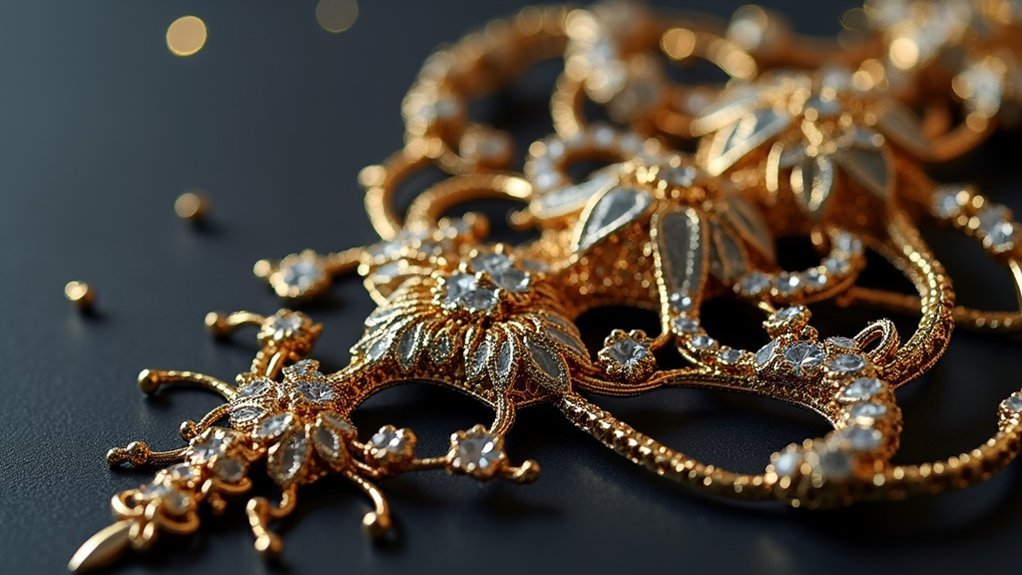
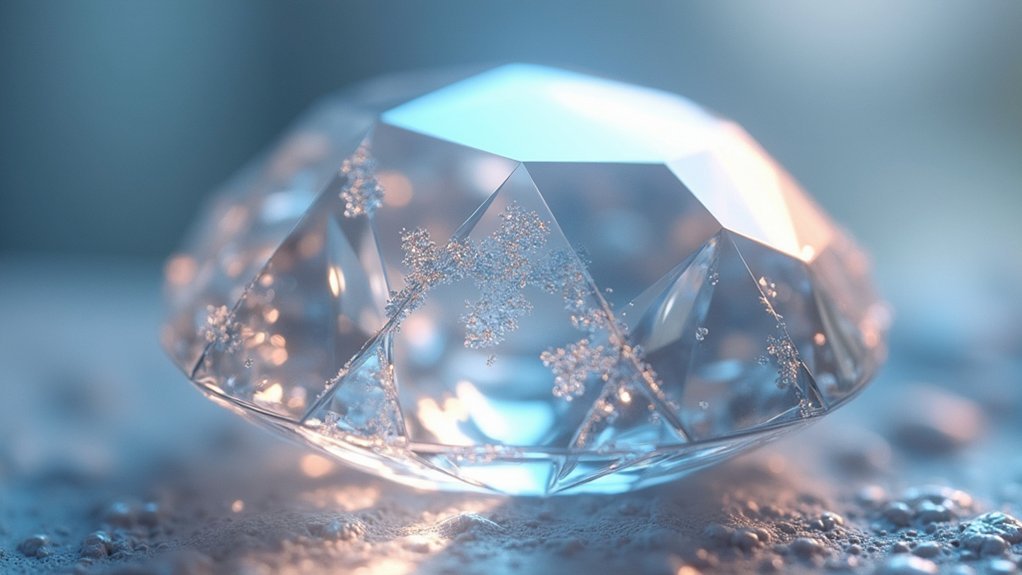

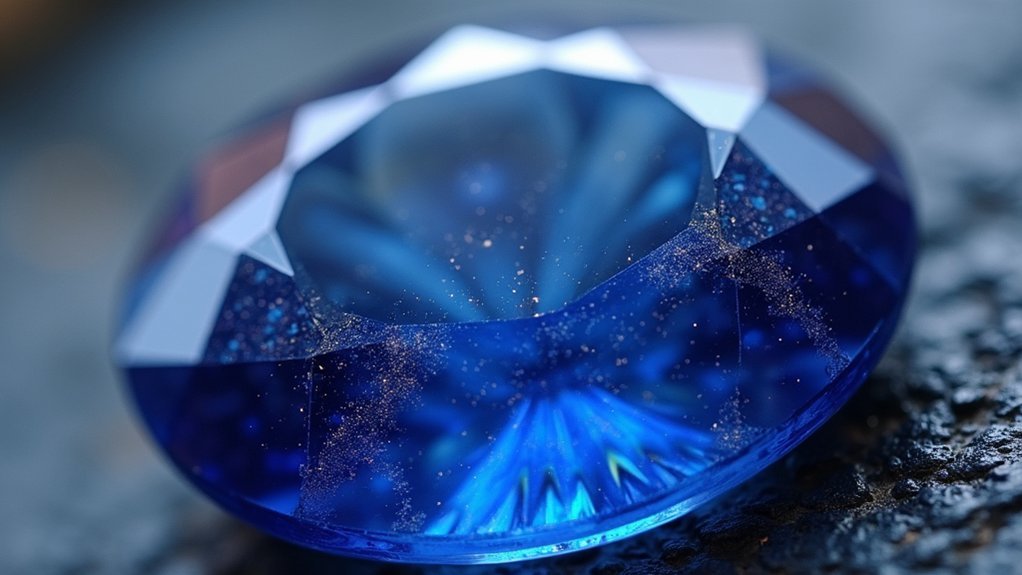
Leave a Reply